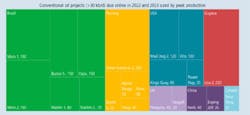IEA: Conventional oil set to dominate 2023 non-OPEC+ supply growth
In a shift from recent years, the majority of non-OPEC+ gains are coming from new conventional projects, according to the International Energy Agency (IEA). US light tight oil (LTO) is expected to provide only one-third of the 1.8 million b/d growth in 2023, down from nearly a half this year. Brazil is the largest source of new conventional supply in the short term, followed by Norway, the US Gulf of Mexico, and Guyana, IEA said.
Brazil is on track to bring on five new FPSO vessels over the next 18 months in addition to the Guanabara FPSO that started up in Mero field earlier this year. Chinese firms also have a slate of domestic projects coming online to meet the government’s energy security goals. Norway has five major projects, including the large Johan Sverdrup Phase 2 start up, expected before yearend 2023 with a total capacity of 360,000 b/d. That’s in contrast to the UK where over the same time period only two smaller projects are expected to increase capacity by 80,000 b/d.
“Almost all of the new projects are concentrated in a handful of mature basins of well-established oil producing countries. This reflects years of dwindling exploration budgets as companies sought to reduce risks and uncertainty regarding the path of the energy transition. The notable exception is Guyana, which saw the second Liza FPSO, Unity, come online in 2022 first quarter and a final investment decision (FID) taken on the project’s fourth FPSO for start-up in 2025,” IEA said.
“Impacts from COVID-19, uncertainties over long-term demand and ongoing pressure from shareholders and financiers to reduce emissions are still being felt by global exploration and production firms even as they reap record profits. Capital expenditures are up 30% from the depths of 2020 but still almost $100 billion below 2019 levels in real terms. If governments act soon to curb oil demand, this could be sufficient. However, in the event that demand remains buoyant, this level of capital spending could further reduce the ability of markets to weather volatility.”


